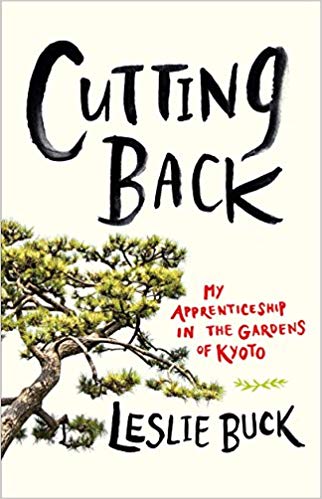

Cutting Back: My Apprenticeship in the Gardens of Kyoto by Leslie Buck. Portland, Oregon: Timber Press, 280 pp., $24.95 (cloth)
Dead needles are plucked by hand from Japan’s most venerable formal garden pines each year to maximize the trees’ freshness; foliage and branches of centuries-old camellias and azaleas are pruned to correct tired postures, and thus the views of and beyond them are reframed. Caring for man-made landscapes in Japan is akin to the oft-cited commentary on Japanese social norms: the highest nail will be hammered into the mainstream pegboard; trees are maintained at an ideal size and shape in a way that freezes time and ensures their harmony with the other vegetation in their natural and sometimes built environment.
Author Leslie Buck was already a successful tree pruner / entrepreneur in the gardens of her hometown of Berkeley, California, but had a gnawing desire to stand on the soil of Japan to learn from local masters of the craft. After taking pruning courses in Berkeley, she decided she would seek out an opportunity to work alongside staff at Uetoh Zoen, one of Kyoto’s oldest and most esteemed landscape companies. Armed with only cursory language capacity, she went to Kyoto to seek work with an elite team of senteishi, tree pruners.
In most of Japan’s traditional crafts, students are apprentices embarking on a “way” through the formalities of the discipline; the boss is sensei. It may take years to acquire even basic acceptable competence, and this is certainly the case in traditional Japanese horticulture. Whether sited in a monastery, temple, shrine, museum, or a family villa, these gardens are literally real estate assets passed down from generation to generation.
If you have never walked in someone’s jikatabi—traditional split-toed work footwear with soles that will not harm moss when it is walked upon— this journal of discovery will inspire a new appreciation for landscape.
Buck is a fine guide through the complexities of being an expat in a deeply traditional world where long-standing relationships rule. It takes humility, cooperation, physical and emotional strength, patience and a keen sense of observation to do this work.
The book chronicles her aesthetic pruning efforts as well as her navigation into the corporate hierarchy as the newest member of the team, albeit one with decades of professional experience in the USA. To gain access to such a rare opportunity required her being handed from one referral to another. Finally, she joined a team of men (as the only woman and only foreigner) on contracted missions to maintain some of the country’s renowned public and private gardens, ranging from the intimacy of an Imperial Villa to tourist destinations. Her language skills were extremely limited, but she learned to communicate not only with the trees and shrubbery, but also with the rest of the team.
In the relaxed narrative voice of her exacting work, she describes, for example, the hashigo—hand-made ladders—that her fellow-workers put up along tree trunks and across branches (sometimes from tree to tree) to enable the arborist artisans to reach the highest branches. Extreme care was taken not to damage the precious hamushiri (bark), a highly valued feature. The work was precise and dangerous. In other roles, she was tasked with washing and precisely replacing rocks so that they would resemble a stream bed. Caring for these precious natural resources takes extreme skill, patience, planning and a unique relationship with nature. Buck worked outdoors six-days-a-week through all types of weather, and relished, with her colleagues, the tea and snacks and lunch shared by clients on the gardeners’ breaks.
Reading Cutting Back taught my untrained eye to more fully appreciate the complexities of Japanese formal gardens and the folks who are entrusted to maintain them.
